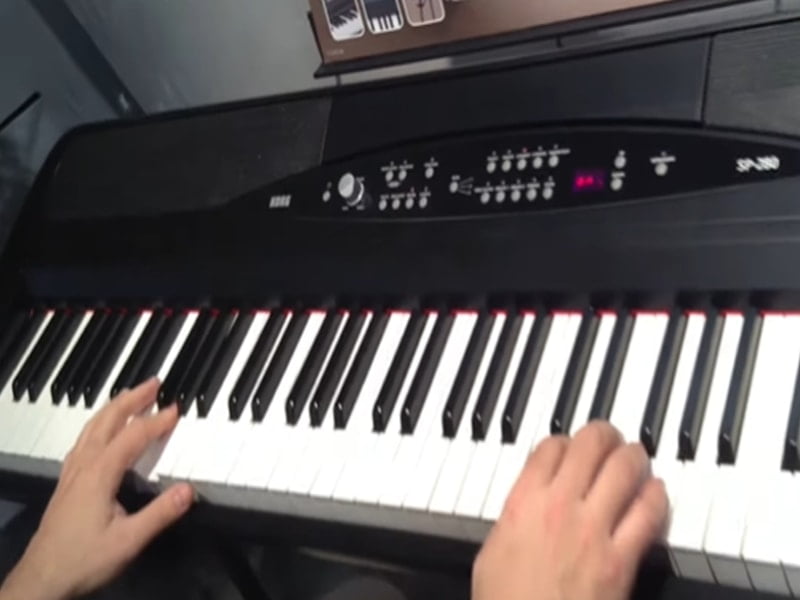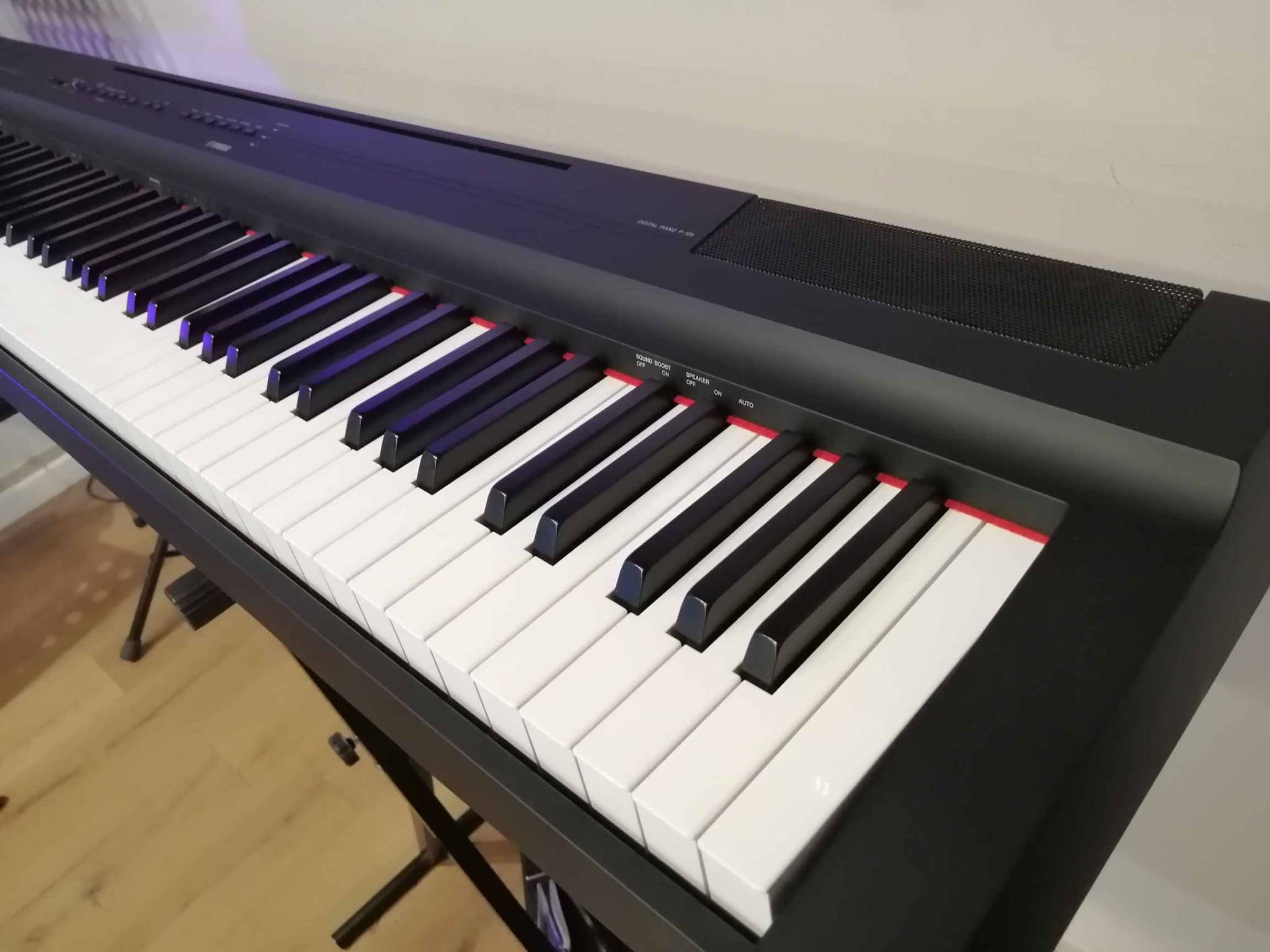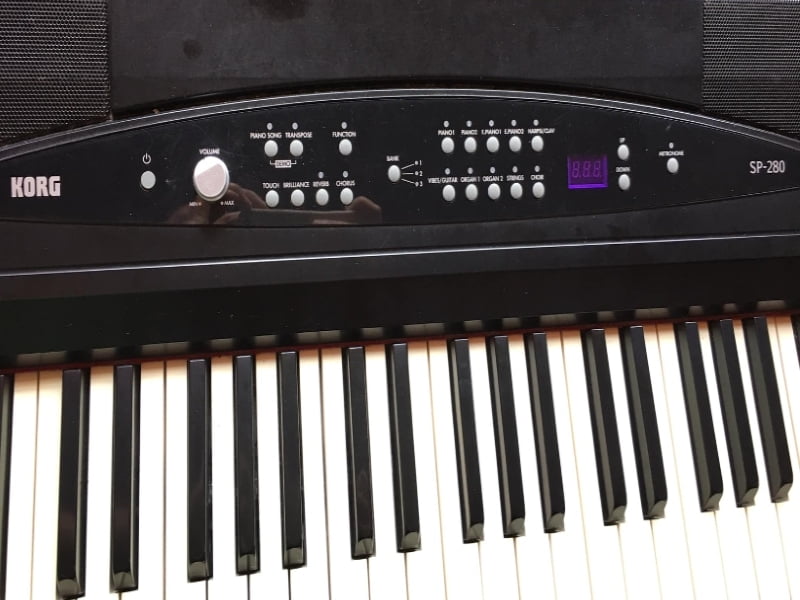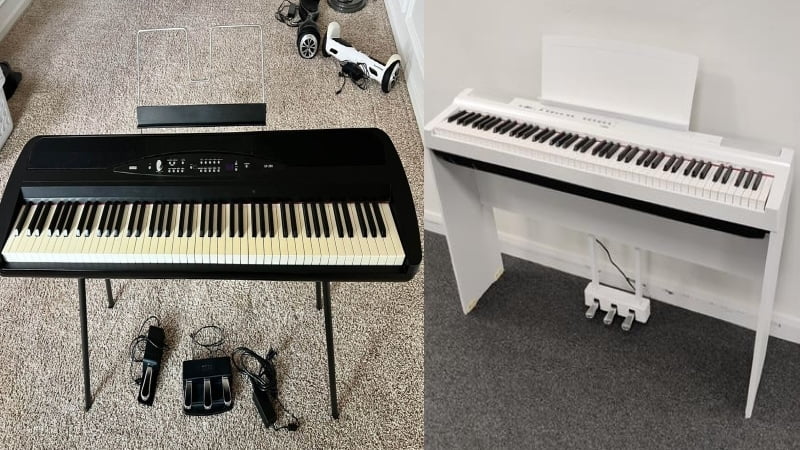After numerous upgrades made on the P125, most of which are quite incredible, does Korg still stand a chance in the Yamaha P125 vs Korg SP 280 match-up?
Korg and Yamaha are two of the most popular and highly-acclaimed digital piano manufacturers in the whole world. It might surprise many that these two actually have a very close relationship to each other, with the latter supplying parts to the former since 1987.
But even then, and possibly especially now, the companies have a healthy competition going on. Both are trying to outdo the other, with every single piece they create. For example, when it comes to digital pianos for beginners, Yamaha released the P or Portable series while Korg came up with the SP line.
The models often set side by side are Yamaha’s P125 and Korg’s SP 280 initially because the two were released almost at the same time (the former in 2015 and the latter in 2013). But many are surprised to find that the two also have very similar features and functions.
When Yamaha made serious revamps in the P115 and named it P125 in 2018, the SP 280 by Korg seemed to be completely overpowered. The question now is, does Korg have a shot at winning in the Yamaha P125 vs Korg SP 280 race in your eyes?
Yamaha P125 vs Korg SP 280: Comparison Chart




Last update on 2025-07-13 / Affiliate links / Images from Amazon Product Advertising API
Yamaha P125 vs Korg SP 280: Head-to-Head Comparison
Although the Yamaha P125 has been upgraded from the P115, many beginners still find it difficult to pinpoint its definitive differences when comparing it to the Korg SP 280.
Obviously, the hammer action and sound engine used in the P125 is completely different from those used in the SP 280. Piano manufacturers do design very specific technology that is completely distinctive from its competitors.
At first glance, the two models have similar features and functions – playing modes, certain effects, and recording capabilities just to name a few. But keyboard connoisseurs understand that even the most minute detail makes a whole lot of difference. And there are loads of these.
After thoroughly inspecting the two digital pianos and playing them side by side, I came up with a few points that could be helpful in your final decision making. Personally, I give the Yamaha P125 vs Korg SP 280 competition to the former 2:1. But do read on if you’d like to get to know more details about these digital pianos.
Feel
The Winner: Tie
This aspect refers to how the digital piano feels under one’s fingertips in comparison to a real acoustic upright or grand, so this is an incredibly important facet to look into.
Marketed as a beginner’s instrument, the feel of P125 and SP 280 are, at best, passable. Personally, I am not a huge fan of the hammer action or the actual keytops found on these two. But if I were a novice player in need of practice equipment that does not cost an arm and a leg, either is acceptable.

+Hammer Action
Acoustic piano keys are connected to a series of internal mechanisms that basically pushes a hammer up to a string which creates the sound. Any self-respecting digital piano manufacturer aims to mimic this action. And both the P125 with Yamaha’s Graded Hammer System and SP 280 with Korg’s Natural Weighted Hammer Action are satisfactorily equipped in this regard.
While the names given to the mechanisms are different, the actual action is the same. And the feel – heavier on the bass and lighter on the treble – is realistic enough.
+Touch Sensitivity
Expression is a very important component in piano playing. When the key is pressed softly, the sound created is soft too. When the key is pounded hard, the sound is louder and more resonant. On top of the actual hammer action, touch sensitivity adds to the authentic feel of an acoustic piano.
The P125 has a bit of an edge here because it has four different levels (Soft, Medium, Hard, and Fixed) while the SP 280 only has three (Light, Normal, and Heavy). But the two are pretty much matched in this regard.
+Key Texture
Most modern acoustic pianos are made of special wood or synthetic ivory and ebony which provides enough friction under the fingertips. Premier digital pianos try to mimic this as well. Unfortunately, our featured instruments sorely fail here because, despite their black matte keytops, the white ones are made of smooth plastic.

Tone
The Winner: Yamaha P125
One advantage of digital versions over its acoustic counterpart is that it can do so much more when it comes to sound, one of which is having a collection of different instruments and pre-set demo songs that can help with training. However, digital pianos should be able to recreate those sounds faithfully.
I gave this particular point to the P125 because their sound engine and library are truly impressive, especially for a piece that is under a thousand bucks. To be fair, the SP 280 is not too bad in this regard either. But it just does not live up to its rival.
+Tone Generator
In the simplest terms, this is the music box of digital pianos. Although each company has a specific name for their technology, the method they use to capture the sound is the same – sampling. The source, on the other hand, is different.
The P-25 is outfitted with the Pure CF Sound that takes four layers of samples from the Yamaha’s CF III Concert Grand. On the other hand, the SP 280 takes its samples from the world-renowned Steinway.
With amazing sources, these two would have been equals. But the four layers on the P125 creates smoother transitions and more vibrant sounds that would match pricier Yamaha models.
+Sound Library
One of the major revamp that Yamaha made on the P115 towards P125 was to increase the number of voices or instruments from 14 to 24. Aside from the several grand voices sampled from the aforementioned CF III, the others (electric, organ, strings, etc.) are incredibly well-sampled and not synthetic-sounding.
However, Korg’s SP 280 wins in this aspect since it has 30 voices – very rarely seen in digital pianos in its price range.
+Demo Tracks
Aside from the sound library of voices, both the P125 and SP 280 have a decent collection of preset songs which anyone can just sit and listen to. The former has 21 demo tracks and 50 piano songs. The latter has less with 20 piano songs.
Piano Functions and Features
The Winner: Yamaha P125
Aside from affordability, the incredible functionality is another attribute which makes digital pianos slightly more interesting than their acoustic versions. And the models from Yamaha and Korg are definitely packed with these.
The SP 280 may have a long list of incredible features which would equal those in the P115. But it falls short considering the additions made in the P125.
+Polyphony
It can be frustrating to play a piano with too low polyphony, especially when your skills are improving. Even if you’re a beginner, it’s best to opt for a digital piano with a max polyphony of 100. Fortunately, the SP 280 has 120 and the P125 has a whopping 192. Obviously, the latter wins in this aspect.

+Playing Modes
Yamaha’s candidate is the victor here again, having all three essential playing modes – Layering (two voices played at the same time), Split (88 keys bisected for two different voices to be played per side), and Lesson (88 keys bisected into two different keyboards at the same octave). The Korg contender only has two: Layering and Lesson mode.
+Effects
The P125 does have more effects than its competitor, with four types of Reverb, IAC, and Sound Boost, just to name a few. However, quality trumps quantity in the realm of digital pianos. This is in no way a disparagement of Yamaha. But while Korg equipped its model with the bare minimum (Reverb, Chorus, and Brilliance), it’s really enough to reinforce the sound.
+Recording Capability and Connectivity
For those who want to check their progress or just capture their own compositions, both the P125 and SP 280 have decent recording capabilities. The former can save up to two MIDI tracks internally which can then be moved to another device via USB. The latter can only save externally using an AUX line out.
+Speaker System
The usual complaint about Yamaha is their lack of good amplification when it comes to their entry-level models. Many will agree with me, it is the one thing that the company should work on.
This is the aspect where Korg SP 280 wins big having a total of 44W of speaker power. Despite its huge wattage, the sound does not get distorted at full volume. And that makes the SP 280 a great instrument, even for live performances with an audience.
Yamaha P125 vs Korg SP 280: The Similarities
Aside from being portable 88-key digital pianos at under $1000, Korg’s SP 280 and P125 are very different when you check under the hood. Although the two have almost the same features and functions, the actual specifications are diverse – as evidenced by the comparative report above. And what that ultimately concludes is that, in the Yamaha P125 vs Korg SP 280 battle, Yamaha made the better piece.
Quick Rundown of the Yamaha P125
- A fully weighted digital piano with 88 full-sized piano-style keys
- GHS weighted action is heavier in the low keys and lighter in the high keys, just like an acoustic piano
- The pure CF sound engine faithfully reproduces the tone of the acclaimed Yamaha 9' CFIIIS Concert Grand piano
- Split Mode lets you play a different voice with each hand
- USB to host connectivity with MIDI and audio transfer means you only need one Cable to connect to your music-making software
Last update on 2025-07-13 / Affiliate links / Images from Amazon Product Advertising API
Quick Rundown of the Korg SP 280
- Rich, dynamic acoustic piano sounds that are enjoyable to play
- Authentic vintage electric piano sounds, perfect for live performance.Power Consumption : 15W
- Natural Weighted Hammer Action (NH) keyboard faithfully reproduces the touch of an acoustic piano
- Lightweight design makes transportation easy
- Stereo audio input is provided, for playing along with external audio sources
Last update on 2025-07-13 / Affiliate links / Images from Amazon Product Advertising API
Product Videos
Related Articles to Yamaha P125
- Yamaha P150 vs P125: The Battle of the P-Series Models
- Yamaha P125 vs CLP 625: Can a Beginner’s Digital Piano Match the Clavinova?
- Yamaha P125 vs Roland FP 60: Which is the Better Investment?
- Yamaha P-121 vs P-125: Finding the Best Portable Yamaha Piano
- Yamaha P125 vs Korg LP 380: Which Piano Is Better for Your Needs?
- Yamaha P125 vs P85: Can the Outdated Digital Piano Beat the Newer One?
- Yamaha P125 vs DGX 670: Which Piano Comes Out on Top?
- Yamaha P-255 vs P-125: Finding the Better Option for Beginners
- Yamaha P125 vs YDP S34 Comparison: Does the Portable P125 Hold Up Against a Console Digital Piano?
- Yamaha P125 Vs YDP 164: Should You Get A Console Or Digital Piano?
- Yamaha YDP 103 Vs P125: Should You Get a Portable or Console Digital Piano?
- Yamaha P125 Vs Kawai ES110 Comparison: Which Is The Best Portable Digital Piano
- Yamaha P125 vs Casio PX S1000: Which Digital Piano Is Worth Your Money?
- Casio PX-870 Vs Yamaha P-125: Should You Get A Portable Or Console Digital Piano?
- Alesis Recital Vs Yamaha P125: Which Is The Right Pick For You?
- Yamaha P45 VS P115: Which P-Series Newbie Gives You More Value for Money?
- Alesis Recital Pro vs Yamaha P125 Comparison: Which Is The Best Portable Digital Piano?
- Alesis Prestige Artist vs Yamaha P125 Comparison: Why the Yamaha P125 Is the Better Investment
- Yamaha P125 vs Casio PX-770 Review: Why the Yamaha P125 Beats Out the Casio Console Digital Piano
- Yamaha P125 vs DGX 660 Comparison: Can the P125 Hold Its Own Against the DGX 660?
- Yamaha P125 vs Roland FP-30X Review: Why the Roland FP-30X Comes Out On Top
- Yamaha P125 vs P515 Review: Why the Yamaha P515 Is the Better Investment
- Yamaha P115 vs P125 Review: Can the P125 Beat Out Its Predecessor?
- Yamaha P125 vs Roland FP30: A Close Battle Between Two Great Digital Pianos
- Yamaha P45 vs P125: Why the Yamaha P125 Is the Better Pick for Pianists
- Yamaha P71 vs P125: Why the Yamaha P125 Is the Better Investment
References:
- Yamaha P125: https://www.sweetwater.com/store/detail/P125BK–yamaha-p-125-88-key-weighted-action-digital-piano-black
- Korg SP 280: https://www.sweetwater.com/store/detail/SP280BK–korg-sp-280-digital-piano-with-speakers-black
Lulacruza is an electronic folk duo operating at the junction of the hypermodern and the ancient. Our music weaves together hypnotic female singing, South American folk instruments and electronic processing, while channeling pulsating waves from the source of creation.
Lalucruza is also a community where you can connect with other music lovers to collaborate, exchange ideas and share knowledge. A platform for who wants to learns the basics of playing piano, guitar, drum masters’ technique, etc.. is the premise of our website.
